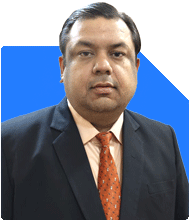Ramalingam Kalirajan |9255 Answers |Ask -Follow
Mutual Funds, Financial Planning Expert - Answered on Jun 05, 2025
He has an MBA in finance from the University of Madras and is a certified financial planner.
He is the director and chief financial planner at Holistic Investment, a Chennai-based firm that offers financial planning and wealth management advice.... more

I am looking for an investment from which I want to withdraw 45k per month with a 10% increase per year for next 15 years. My approximate investment amount is 85L. How should I distribute and invest in different financial instruments so that I can get monthly amount(45k with 10% increase every year) and end of 15 years get back by invested amount(85L).
You want to withdraw Rs 45,000 per month, increasing by 10% yearly, for 15 years.
You also want to get back your original Rs 85 lakhs at the end of 15 years.
This is a systematic withdrawal strategy. It needs a structured, safe, and inflation-adjusted plan.
Let’s create a detailed 360-degree financial strategy to help you achieve this confidently.
Understanding the Goal in Simple Terms
Monthly income need: Rs 45,000 starting now.
Yearly increase: 10% to beat inflation.
Duration: 15 years continuous cash flow.
Final goal: Get back Rs 85 lakhs after 15 years.
Focus: Safety of capital + income growth + liquidity + tax-efficiency.
Step-by-Step Investment Logic
You are looking at three important things:
Regular rising monthly income
Protection of the capital invested
Long-term wealth preservation
To achieve all three together, we must divide your money into 3 structured buckets.
Bucket 1 – Income for First 5 Years (Rs 25 Lakhs)
This will fund your monthly withdrawals for the first 5 years.
Put this in hybrid conservative mutual funds or low volatility short-duration debt funds.
These will give you better post-tax returns than FDs.
Use Systematic Withdrawal Plan (SWP) for monthly withdrawals.
Withdraw only what is needed each month, let rest continue to grow.
This bucket is low risk, liquid, and designed for cash flow.
Taxation: Gains taxed as per income slab (for debt-oriented), or 12.5% for equity-based funds if long-term.
Plan for Rs 45,000/month for Year 1, then Rs 49,500/month for Year 2, and so on.
Adjust SWP every year as per need.
This protects your capital and ensures steady income.
Bucket 2 – Income for Year 6 to Year 10 (Rs 27 Lakhs)
This will fund your income from year 6 to year 10.
Invest this in balanced advantage or aggressive hybrid mutual funds through regular plans.
These funds have equity and debt mix.
Suitable for 5+ years holding.
These grow in early years and will be used later when Bucket 1 gets exhausted.
Avoid index funds, they can't manage risk in volatile markets.
Actively managed funds perform better in India due to market inefficiencies.
Keep this untouched for 5 years.
In 6th year, start SWP from this bucket.
Withdraw Rs 72,440/month in 6th year, increasing 10% per year till 10th year.
Rebalance if required with help of a certified financial planner.
Bucket 3 – Wealth Protection and Capital Return (Rs 33 Lakhs)
This will grow silently for 15 years.
Invest in actively managed equity mutual funds via regular plans.
Use large-cap and multicap funds with long-term track record.
Do not go for direct plans. They lack expert guidance.
Regular plans through a certified planner ensure monitoring and rebalancing.
Direct funds can look cheap, but missteps reduce returns.
Stay invested in this bucket for entire 15 years.
This bucket should grow to match your original capital of Rs 85 lakhs at end.
Compounding works best in this last bucket.
Avoid annuity or insurance products here.
Do not lock into ULIPs or endowment policies.
Avoid Index Funds in Your Case
You may come across index funds with low cost.
But please note:
Index funds cannot avoid market crash. No active risk management.
They follow the market blindly.
No protection in falling market phases.
They don’t suit income planning models.
You need consistency and controlled volatility, not index-based randomness.
Actively managed funds aim to beat index returns with better downside protection.
Go with actively managed mutual funds with experienced fund managers.
Why Not Use Direct Plans?
You may think direct plans save cost.
But here's the reality:
There is no personal review or hand-holding in direct plans.
They can lead to wrong fund choice or wrong timing.
If you need changes later, there is no structured support.
Most investors don’t track direct funds actively.
Investing through a certified financial planner and MFD ensures professional support.
Regular plans help you with portfolio review, SWP adjustment, and fund switch when needed.
Over 15 years, this guidance can save lakhs.
Tax Planning Matters
Let us now talk about tax implications in your case.
SWP from equity funds held more than one year has 12.5% tax on LTCG above Rs 1.25 lakh yearly.
SWP from debt funds are taxed as per income slab.
Equity-oriented hybrid funds are tax-efficient for 5+ years SWP.
No TDS is applicable in mutual fund SWP.
You declare and pay tax while filing.
Capital gain calculation is automatic in fund statements.
Always track withdrawals and gains annually.
Annual Plan Review
Investing is not one-time.
Every year, review with your certified planner.
Adjust SWP if markets are volatile.
Rebalance buckets if needed.
Ensure your income flow is not disturbed.
Consider income reinvestment if market gives excess gains.
Never pause your review process.
Stay disciplined throughout the 15 years.
Emergency Buffer Outside This Plan
Keep Rs 3–4 lakhs separately in a liquid fund or savings-linked sweep account.
This is not part of Rs 85 lakhs.
It is for sudden health or family expenses.
This protects your main investment plan.
Never break SWP plan due to one-time emergency.
What to Strictly Avoid
Please avoid the following mistakes:
Don’t invest this amount in real estate.
Don’t take suggestions from agents who are not CFPs.
Don’t invest in traditional LIC plans, ULIPs or endowment policies again.
Don’t touch capital for big spending in between.
Don’t put full Rs 85 lakhs in equity or in FDs.
Don’t start SIP or SWP without a structured strategy.
Don’t expect same return every year.
Don’t ignore tax and inflation impact.
Smart Strategy Summary
Let’s recap the plan briefly in bullet points:
Bucket 1: Rs 25 lakhs for years 1–5 income via SWP from conservative hybrid or debt funds.
Bucket 2: Rs 27 lakhs for years 6–10 income via SWP from balanced advantage funds.
Bucket 3: Rs 33 lakhs for capital recovery after 15 years through equity mutual funds.
Keep Rs 3–4 lakhs as emergency buffer.
Withdraw Rs 45,000/month with 10% hike annually.
Stay invested, stay disciplined, do yearly review.
Avoid direct and index funds.
Avoid insurance-linked investments and annuities.
Use only regular funds with support from a Certified Financial Planner.
Stay consistent for 15 years to meet both goals.
Finally
This is a 15-year plan. It supports your monthly income and gives capital safety.
It requires discipline, diversification, and timely review.
Avoid DIY mistakes. Stick to your plan with expert guidance.
This structured plan gives you peace and confidence.
You can live stress-free for 15 years without touching your capital.
And at the end, you get back your full Rs 85 lakhs.
Best Regards,
K. Ramalingam, MBA, CFP,
Chief Financial Planner,
www.holisticinvestment.in
https://www.youtube.com/@HolisticInvestment
You may like to see similar questions and answers below
Ajit Mishra | Answer |Ask -Follow
Answered on Sep 07, 2021
Ramalingam Kalirajan |9255 Answers |Ask -Follow
Mutual Funds, Financial Planning Expert - Answered on May 06, 2024
Ramalingam Kalirajan |9255 Answers |Ask -Follow
Mutual Funds, Financial Planning Expert - Answered on Jul 15, 2024
Ulhas Joshi | Answer |Ask -Follow
Mutual Fund Expert - Answered on Aug 30, 2024
Ramalingam Kalirajan |9255 Answers |Ask -Follow
Mutual Funds, Financial Planning Expert - Answered on Feb 04, 2025
Radheshyam Zanwar |4292 Answers |Ask -Follow
MHT-CET, IIT-JEE, NEET-UG Expert - Answered on Jun 28, 2025
Yogendra Arora |36 Answers |Ask -Follow
Tax Expert - Answered on Jun 28, 2025
Yogendra Arora |36 Answers |Ask -Follow
Tax Expert - Answered on Jun 28, 2025
Radheshyam Zanwar |4292 Answers |Ask -Follow
MHT-CET, IIT-JEE, NEET-UG Expert - Answered on Jun 28, 2025
Radheshyam Zanwar |4292 Answers |Ask -Follow
MHT-CET, IIT-JEE, NEET-UG Expert - Answered on Jun 28, 2025
Dr Nagarajan J S K |1432 Answers |Ask -Follow
NEET, Medical, Pharmacy Careers - Answered on Jun 28, 2025
Dr Nagarajan J S K |1432 Answers |Ask -Follow
NEET, Medical, Pharmacy Careers - Answered on Jun 28, 2025
Dr Nagarajan J S K |1432 Answers |Ask -Follow
NEET, Medical, Pharmacy Careers - Answered on Jun 28, 2025
Dr Nagarajan J S K |1432 Answers |Ask -Follow
NEET, Medical, Pharmacy Careers - Answered on Jun 28, 2025
Dr Nagarajan J S K |1432 Answers |Ask -Follow
NEET, Medical, Pharmacy Careers - Answered on Jun 28, 2025
























